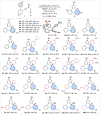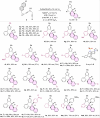Asymmetric Büchner reaction and arene cyclopropanation via copper-catalyzed controllable cyclization of diynes
- PMID: 39455569
- PMCID: PMC11511906
- DOI: 10.1038/s41467-024-53605-7
Asymmetric Büchner reaction and arene cyclopropanation via copper-catalyzed controllable cyclization of diynes
Abstract
The asymmetric Büchner reaction and related arene cyclopropanations represent one type of the powerful methods for enantioselective dearomatization. However, examples of asymmetric Büchner reactions via a non-diazo approach are quite scarce, and the related arene cyclopropanation based on alkynes has not been reported. Herein, we disclose an asymmetric Büchner reaction and the related arene cyclopropanation by copper-catalyzed controllable cyclization of N-propargyl ynamides via vinyl cation intermediates, leading to chiral tricycle-fused cycloheptatrienes and benzonorcaradienes in high yields and enantioselectivities. Importantly, this protocol represents an asymmetric arene cyclopropanation reaction of alkynes and an asymmetric Büchner reaction based on vinyl cations.
© 2024. The Author(s).
Conflict of interest statement
The authors declare no competing interests.
Figures







Similar articles
-
Divergent and Enantioselective Synthesis of Three Types of Chiral Polycyclic N‑Heterocycles via Copper-Catalyzed Dearomative Cyclization.ACS Cent Sci. 2025 May 2;11(5):805-815. doi: 10.1021/acscentsci.5c00248. eCollection 2025 May 28. ACS Cent Sci. 2025. PMID: 40454337 Free PMC article.
-
Cyclopropanation of Benzene Rings by Oxidatively Generated α-Oxo Gold Carbene: One-Pot Access to Tetrahydropyranone-Fused Cycloheptatrienes from Propargyl Benzyl Ethers.Adv Synth Catal. 2018 Feb 15;360(4):647-651. doi: 10.1002/adsc.201701322. Epub 2017 Nov 14. Adv Synth Catal. 2018. PMID: 31814809 Free PMC article.
-
Copper-Catalyzed Asymmetric Reaction of Alkenyl Diynes with Styrenes by Formal [3 + 2] Cycloaddition via Cu-Containing All-Carbon 1,3-Dipoles: Access to Chiral Pyrrole-Fused Bridged [2.2.1] Skeletons.J Am Chem Soc. 2020 Apr 22;142(16):7618-7626. doi: 10.1021/jacs.0c01918. Epub 2020 Apr 14. J Am Chem Soc. 2020. PMID: 32237743
-
Rhodium(II)-catalyzed alkyne amination of homopropargylic sulfamate esters: stereoselective synthesis of functionalized norcaradienes by arene cyclopropanation.Org Lett. 2014 Jan 3;16(1):74-7. doi: 10.1021/ol403035g. Epub 2013 Dec 16. Org Lett. 2014. PMID: 24328560
-
Recent advances in transition-metal-catalyzed Büchner reaction of alkynes.Org Biomol Chem. 2023 Jun 28;21(25):5150-5157. doi: 10.1039/d3ob00654a. Org Biomol Chem. 2023. PMID: 37325882 Review.
Cited by
-
Copper-catalyzed direct regioselective C5-H alkylation reactions of functionalized indoles with α-diazomalonates.Chem Sci. 2025 Jul 15;16(33):14967-14975. doi: 10.1039/d5sc03417e. eCollection 2025 Aug 20. Chem Sci. 2025. PMID: 40698159 Free PMC article.
-
Divergent Synthesis of Polycyclic N‑Heterocycles via Controllable Cyclization of Divinylallenes Catalyzed by Copper and Gold.JACS Au. 2025 Jul 22;5(8):4094-4105. doi: 10.1021/jacsau.5c00760. eCollection 2025 Aug 25. JACS Au. 2025. PMID: 40881415 Free PMC article.
-
Divergent and Enantioselective Synthesis of Three Types of Chiral Polycyclic N‑Heterocycles via Copper-Catalyzed Dearomative Cyclization.ACS Cent Sci. 2025 May 2;11(5):805-815. doi: 10.1021/acscentsci.5c00248. eCollection 2025 May 28. ACS Cent Sci. 2025. PMID: 40454337 Free PMC article.
-
Ligand-controlled divergent asymmetric C(sp3)-H and C(sp3)-O insertion via vinyl cations.Nat Commun. 2025 May 2;16(1):4107. doi: 10.1038/s41467-025-59328-7. Nat Commun. 2025. PMID: 40316525 Free PMC article.
References
-
- Liu, Y.-Z., Song, H., Zheng, C. & You, S.-L. Cascade asymmetric dearomative cyclization reactions via transition-metal catalysis. Nat. Synth.1, 203–216 (2022).
-
- Xia, Z.-L., Xu-Xu, Q.-F., Zheng, C. & You, S.-L. Chiral phosphoric acid-catalyzed asymmetric dearomatization reactions. Chem. Soc. Rev.49, 286–300 (2020). - PubMed
-
- Sheng, F.-T., Wang, J.-Y., Tan, W., Zhang, Y.-C. & Shi, F. Progresses in organocatalytic asymmetric dearomatization reactions of indole derivatives. Org. Chem. Front.7, 3967–3998 (2020).
LinkOut - more resources
Full Text Sources

